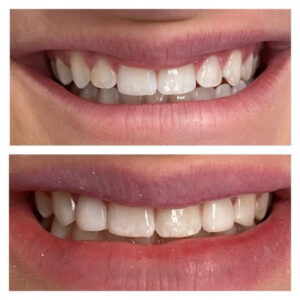Contouring the shape is one of the ways to improve the teeth’s condition if a patient has cracked, fractured and uneven teeth. Reducing the length or the addition of a few millimeters of tooth-colored composite can add radiance to your smile without any pain and discomfort.
Dental contouring is a cosmetic dentistry technique that removes small amounts of tooth enamel (the outer covering of the tooth) in order to change the shape, length, or surface of one or more teeth. “Even a few millimeters of reduction in the right places can really improve the appearance of teeth,” says Dr. Harms, who has a private dental practice in Farmington, Minn. The process is often combined with bonding – a cosmetic dentistry treatment that uses tooth-colored composite material to sculpt and shape the teeth.
An ideal candidate would have minor imperfections in their teeth such as small chips, minor unevenness, slight overlaps, shallowly pitted surfaces, or worn biting areas in their teeth. Other indications for the procedure are one or more teeth out of proportion in size to the rest of the set, such as large, pointy canine teeth. Note that reshaping can only occur on healthy teeth, so x-rays are often taken before the procedure is done to check for problems. Some characteristics of the teeth that might preclude reshaping are: thin enamel, previous extensive restorations of the tooth or surrounding teeth, recently erupted teeth, teeth having gum structure that would be disturbed by the procedure, or teeth that are still shifting. Some contouring is not recommended if it will adversely affect the patient’s bite.
Visit our “before and after” gallery

